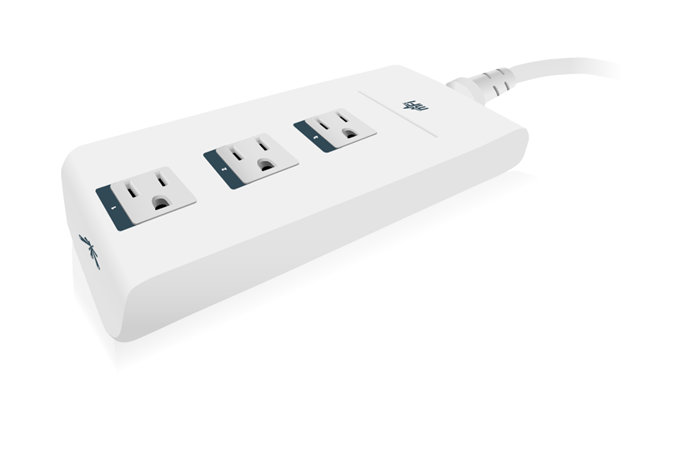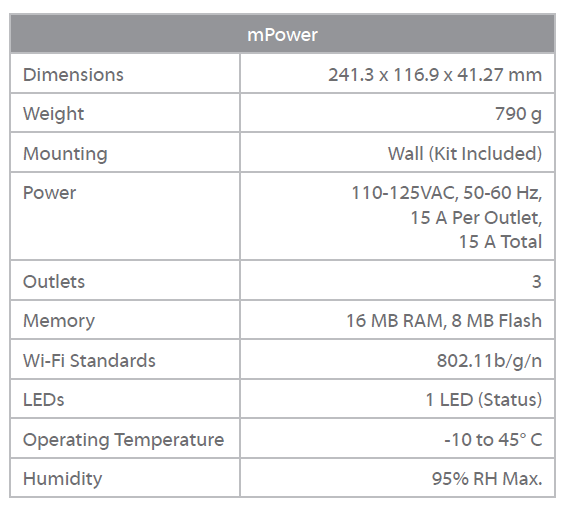Ubiquiti Networks mFi mPower Wi-Fi Power Strip Review
by Ganesh T S on November 21, 2013 3:00 AM EST- Posted in
- Home Automation
- Wi-Fi
- Ubiquiti Networks
- IoT

Introduction
The Internet of Things (IoT) revolution is happening right now. As smartphones proliferate, consumers want the ability to control devices in an automated and easy manner. Remotely switching a power outlet is one of the basic building blocks of an automation system (home or business building). Last year, we reviewed Visible Energy's UFO Power Center, a standalone device which combined energy awareness and home automation in a striking package. Today, we are looking at Ubiquiti's mPower mFi power strip. This is a device with similar features (ability to turn on/off an outlet over a wireless network and measure the power consumed by a device connected to an outlet). However, it caters to a very different market segment.
Ubiquiti Networks - Background
Ubiquiti Networks started off as a manufacturer of wireless products for enterprises, aiming mainly at emerging markets. We have generally found that their kits cost much lower than the competition (and it is attributed mainly to the fact that they don't employ a dedicated sales / marketing team). A couple of years ago, Ubiquiti started looking into expanding their product portfolio. One of the under-served product categories amongst businesses (Ubiquiti's target customers) is that of building automation. As home automation picks up steam, building automation (a term that I will use to talk about home automation technologies from the perspective of an office building) can be expected to follow. Ubiquiti launched the mFi product category to catch this wave. Ubiquiti calls the mFi as the reinvention of machine-to-machine (M2M) communication.
mFi - A Platform for Building Automation
The mFi product category consists of three main products, the mPort, mPort Serial and mPower. A number of sensors (under the mSensor category) are also included, and these interface with the mPort units through a Cat 5 cable. These include door sensors, motion detectors (both wall and ceiling varieties), temperature and current sensors. The mPort Serial provides a remote serial connection for any other devices controllable through a serial interface. Control of multiple such devices is integrated in a management software called mFi. Written in Java, it is compatible with multiple platforms.
Introducing the mPower
The product we are going to cover in detail today is the mPower. It comes in three variants, all of which support connection to a Wi-Fi network. The fundamental difference is in the number of switchable outlets. The mPower Mini has one, the mPower has three and the mPower Pro has eight. The mPower Pro also has a wired network port. Simply put, the mPower units allow the outlets to be turned on / off over the network using the mFi management software as well as a web interface. Essential statistics about each outlet (VRMS, IRMS, power factor and active power) are also reported through both avenues.
The mPower retails for around $60. The mFi controller software is bundled free with the unit. The mPower Pro (8-outlet version) retails for around $100, which represents better value per outlet. However, the Pro units were not easy to source since Ubiquiti had some supply constraints. Ubiquiti's products are not present in the usual retail channels. Instead, they are sold by B2B vendors (who sometimes have a presence on Amazon). The specifications of the mPower, as provided by Ubiquiti, are presented in the table below.

In the remainder of this piece, we will look at the setup and usage impressions, followed by details of the mPower platform. We will also present one of our custom applications developed for the mPower, thanks to its open platform. This will be followed by a few concluding remarks summarizing the pros and cons of the unit.










61 Comments
View All Comments
daar - Thursday, November 21, 2013 - link
Thanks for the review, introduction could use some work when it comes to chunking info about the product, though.darwinosx - Thursday, November 21, 2013 - link
Yeah it's not clear what this product does.ydeer - Thursday, November 21, 2013 - link
Glad I’m not the only one who is confused. At first I thought it is a 802.11 <-> powerline <-> CAT5 access point, but apparently it is a "X10-like" powerstrip with WiFi. I think?eli2k - Thursday, November 21, 2013 - link
can you access the power outlets with the device connected only to the wifi network and host w/the mFi software turned off? or do I always have to have a host computer running?ganeshts - Thursday, November 21, 2013 - link
Yes, this is possible. In fact, you can use the unit without even linking it to a mFi host. (Though you do need the mFi host to upgrade the firmware on the mPower, you can always uninstall the mFi from the host computer afterwards)simpsond - Tuesday, November 26, 2013 - link
I wrote a little library which will SSH into the mPower and run the appropriate commands to enable read/write, toggle the acutators, and sample the ports. It can be found here: https://github.com/dansimpson/mfiPhelerox - Thursday, November 21, 2013 - link
This product is really interesting because it's very similar to my Bachelor of Science thesis where we, between January and May of this year, made a working prototype of a smart power strip that (over WiFi) reports power consumption for its outlets to a Web server, and of course allows for remote controlling the state of the outlets on the website. The hardware has an 8-bit AVR microcontroller, WiFi, solid-state relays and measurement hardware on a custom PCB. The website uses Django and supports multiple users and multiple power strips per user (unfortunately we've only made one final prototype so far), and some basic automation functionality (though we didn't have time to implement most of our automation ideas, for example a location-aware smartphone app or IFTTT integration). I don't know if it interests anyone, but I'll provide a link to the report we wrote: https://www.dropbox.com/s/7zal1ajnhs0nnad/A_Smart_...Duodecim - Thursday, November 21, 2013 - link
I've been checking a lot of these home automation devices recently. Some years ago I had simple and cheap remote controlled power sockets, and I've been waiting for some progress and a standard to emerge. I remembered checking these specific Ubiquity devices, read about the Java software, but somehow missed the SSH functionality.I'm very interested in the openness of these devices, as I could write my own open-source software to run on an ARM mini-server or even a Meego/Sailfish phone application instead of being stuck with some closed and highly proprietary platform. It would also make it easier to check if some basic security has been implemented so hijacking these gadgets won't be too easy.
I hope some sort of standard emerges for these kind of devices and the sort of "intelligent" light bulbs like LIFX and Phillips Hue though, as a zillion different protocols, remotes and apps would ruin the experience and make life harder rather than easier.
I like the geek angle in this review, thanks!
Verdant - Thursday, November 21, 2013 - link
To me, the app glut is the part the ubiquity environment that needs to be solved first...zeebo - Thursday, November 21, 2013 - link
You're delaying the Macbook Pro review for stuff like a power strip? Come the hell on.